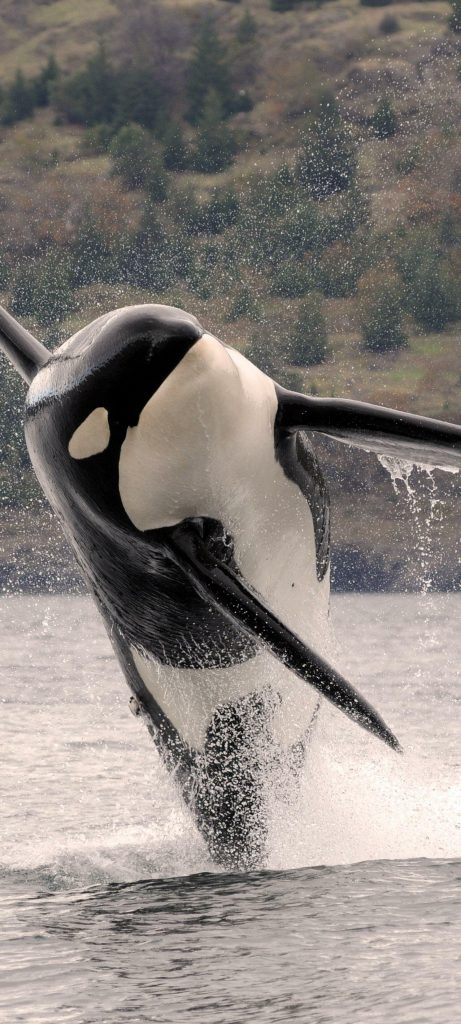New research finds that rules to protect endangered southern resident killer whales could mean less demand for commercial whale watching — but tour operators have options for making up the difference
Maddie Hansen, WSG Science Communications Fellow
 The Salish Sea is a beacon for whale enthusiasts: it is possible to view many types of whales in the stunning landscape including minke whales, gray whales, humpbacks and orcas. As a student studying at the Friday Harbor Labs, I had the chance to see orcas and several porpoises; the first time seeing a whale breach the surface is electrifying, and I will always remember the feeling. Tourists flock from all over the world to pay for this type of experience, especially to see the famous Southern Resident killer whales.
The Salish Sea is a beacon for whale enthusiasts: it is possible to view many types of whales in the stunning landscape including minke whales, gray whales, humpbacks and orcas. As a student studying at the Friday Harbor Labs, I had the chance to see orcas and several porpoises; the first time seeing a whale breach the surface is electrifying, and I will always remember the feeling. Tourists flock from all over the world to pay for this type of experience, especially to see the famous Southern Resident killer whales.
However, the Southern Resident population has been steadily declining, with only 73 individuals estimated left. This trend prompted a state-commissioned task force to address the problem, which led the Washington State Fish and Wildlife Commission to adopt new rules in December 2020 that affect commercial whale-watching companies. Because of these rules, in summer when the whales are more active in the Salish Sea, there are a limited number of boats and limited times that whale watching expeditions can operate in the water. The purpose of these rules is to increase protections for these beloved whales, but the context of Salish Sea whale watching means that the rules may have other effects as well. With funding from Washington Sea Grant, a team of researchers led by Hem Nalini Morzaria-Luna, a marine ecologist with Long Live the Kings, and Melissa Knox, an economist at the University of Washington (UW), studied the potential economic impacts of these rule changes. The researchers found that the rule change could cause a decrease in demand for whale watching — but it also shows that whale watching operators have options for maintaining their clients by diversifying the types of whales that they focus on.
“The goal of the project was to measure how much consumers were willing to pay for whale watching based on rule changes,” explains Abby Schamp, a graduate researcher within the UW School of Economics who carried out the study. Because of the difficulty of in-person research during the COVID-19 pandemic, Schamp and her colleagues conducted an online survey to gauge how consumers would react to the rule change. This type of experiment is called “discrete choice” and is used in many different types of research — on everything from clothing to cereal. The team placed an advertisement on Facebook to ask whether users were interested in orcas, which then led respondents from all over the country to the survey which was filled with questions based on different aspects of whale watching. The survey included a background paragraph on whales in the Salish Sea, whale watching, and the rule changes to provide context.
The survey queried respondents about potential attributes of whale watching, including three key attributes: how close they would be able to get to the whales, how many boats would be in the water, and what types of whales they would see. Of these, viewing distance to whales was the most important to the respondents. The survey results show that a change in distance from 300 yards to 200 yards could yield a predicted seven percent decrease in demand for the industry.
For companies operating in the Salish Sea, this is not ideal. However, the type of whale viewed did not negatively affect the demand, so companies could retain their customers by shifting their focus from the Southern Residents to whales such as humpbacks or the non-endangered Bigg’s killer whales. The other good news for whale watching companies is that demand stays constant for the majority of their customers: “Most customers will go whale watching under any attribute circumstances,” Schamp says. It’s the tourists in the margins that drive the changes in demand.
This research is important because the effects of rule changes on whale watching in general have been fairly uncertain — especially in situations where there are multiple types of whales to view. The Bigg’s killer whales and Southern Resident killer whales look very similar to most people — and there are also humpbacks, minkes, and porpoises swimming the Salish Sea. Second to viewing distance, the researchers found that patrons tend to care more about the number of boats in proximity to them; most care about one of these attributes enough to pay a higher price.
Not only is this project impactful for people locally, it is also valuable as a framework for future conservation research. Whale watching is a popular and culturally significant activity for those in the Salish Sea and beyond; according to a 2018 report from Earth Economics, tours in San Juan County alone generated approximately $216 million of economic activity.
The Salish Sea is a beautiful region teeming with so much marine life that anyone is sure to enjoy a trip regardless of the rules governing the whale watching industry. I know that each time I have seen a whale — whether from a boat or from shore — I have treasured the experience.
www.wsg.uw.edu
Join the conversation: @WASeaGrant and Facebook.com/WaSeaGrant.
SEP
2022